(6 images) Larus fuscus fuscus 2cy-3cy CNMR August 2002 & July 2003, Tampere, Finland (61.33N 24.59E).
An example of an average 2cy fuscus in Finland, which is moulting the inner primaries, the outer median and lower lesser coverts and scapulars. Ringed as 2cy fuscus on August 11 2002, ringed white CNMR and metal HT-238.599.
Hand: 400 mm, which is exactly the length of the much bulkier argentatus which were caught at Tampere. However, fuscus is much slimmer of course.
Left wing: P1-P2 missing, P3-P9 second generation, P10 still juvenile. Arrested primary moult in this wing. S1-S2 grey-based second generation, S3-S8 black-based second generation, S9-S18 juvenile.
Right wing: P1-P3 missing, P4-P9 second generation with P9 rather worn, P10 growing. S1 grey-based second generation, S2-S9 black-based second generation, S10-S18 juvenile.
Rectrices: R1-R6 are worn second generation feathers.
C5UJ was ringed in Tampere, Finland (61.33N 23.59E), ringed as 2cy in summer 2002: August 11 2002 by Risto Juvaste. Considering the upper-part moult, this is another example of typical Finnish fuscus, representing average 2cy fuscus.
Recorded at Tampere:
2002-08-11,
2003-06-16, 2003-06-17, 2003-06-18, 2003-06-29, 2003-07-01, 2003-07-05, 2003-07-06, 2003-07-09, 2003-07-11, 2003-07-12.
After July 12 2003, CNMR wasn't seen again at Tampere dump despite intense visits and may have moved further south from that date on.
In the right wing, the greater coverts are plain grey second generation feathers. 75% of the median coverts are missing and some all dark feathers are probably third generation feathers. There is one lower lesser covert new third generation and 40% missing feathers. The lesser coverts are plain grey second generation feathers, some with a pronounced shaft streak, some with a broad dark central wedge. About 25% of the lesser coverts is missing.
4 images: fuscus 2cy CNMR, August 10 2002, Tampere, Finland.
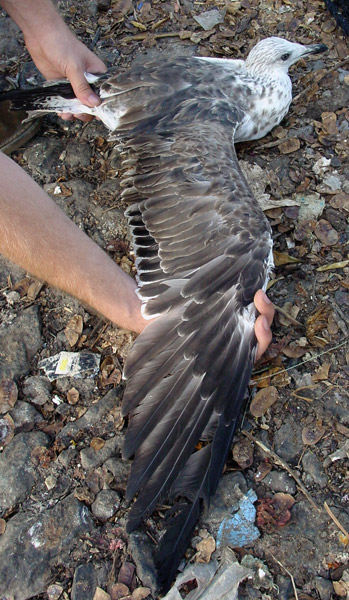
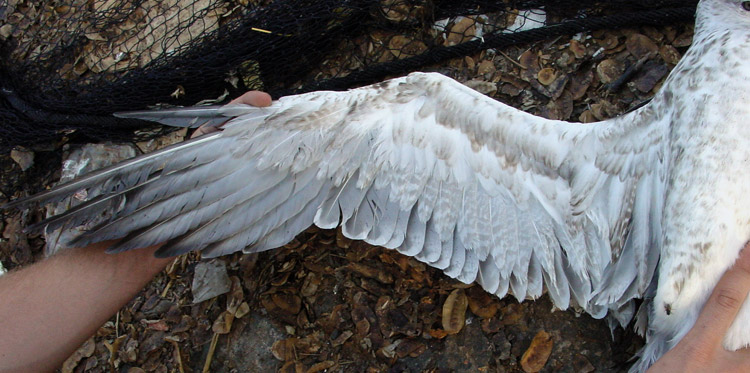

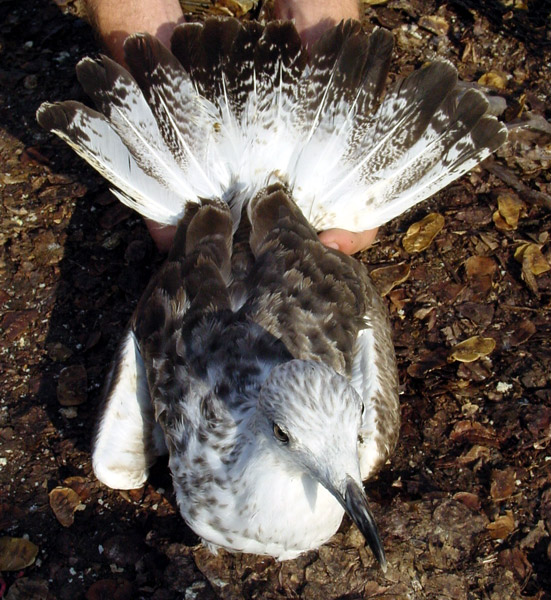
2 images below: Larus fuscus fuscus 3cy CNMR, July 11-12 2003, Tampere, Finland.
Larus fuscus fuscus in 2cy often returns with completely replaced primaries and secondaries. In 3cy, fuscus more often shows a clear division between fresh inner primaries and older outer primaries, the inner primaries often showing neat white tips and the outer primaries often second generation-like with rounded tips and paler bleached brown. The arrested moult in the primaries is often reflected in the secondaries and (to a less extend) in the tail-feathers as well. The older tail-feathers (often R5 is older) still show a broad dark sub-terminal band.
3cy fuscus often have some black markings on the bill, which is otherwise much adult-like, with a clear red gonydeal spot. The colour of the naked parts are adult-like as well.
The scapulars in 3cy are often completely adult-like, lacking internal patterns; plain blackish grey with a mahogany hue on the older feathers. Most wing-coverts and tertials are adult-like blackish grey as well, but often 3cy birds show some very bleached pale brown wing-coverts, normally in the greater covert bar and in the upper rows of the lesser coverts. These bleached wing-coverts accentuate the jumpy sequence in the last wing-covert moult cycles, as there is often no clear pattern in location of these bleached feathers. Head and body feathers normally are snow-white by July.
CNMR, now in 3cy, has the six outer primaries bleached brown in the right wing. The small white crescents are already worn away. Interestingly, the arrested moult in the left wing in 2cy (P10 in the left wing was not included in the first moult wave) is reflected in 3cy: again P10 stands out as a pale brown primary, obvious one generation older than the other primaries.
Back at northern latitudes, CNMR probably continued primary moult after returning in Scandinavia; P1 is fresh 4th generation, P2-P3 are growing and P4 is missing by mid-July. In the left wing: P5-P9 are old 3rd generation. In the right wing: P5-P10 are old 3rd generation with an obvious mirror on P10. Sometimes 2nd generation P10 may show a mirror as well, a mirror which is smaller and ill-defined. Here, CNMR is showing a relatively large mirror, almost reaching to both inner and outer-edge of P10. These outer primaries have been required on the wintering ground.
The bottom image reveals the moult stage in the inner primaries, also showing the old 3rd generation P5. In graellsii and intermedius, the related taxa which moult the primaries in the basic moult between April - October, 3rd generation P5 looks more adult-like (see image at the bottom of this page). In CMNR, there is hardly any white on the P5-tip left and the sub-terminal band (obvious on 3rd generation P5 in graellsii / intermedius) is lacking; the pale brown inner-web gradually dissolves in the darker brown outer-web.
Note the fresh outermost secondary in the bottom image, showing a grey base (with slight brown hue) and large white tip, the common pattern in 3rd generation secondaries. Most of the 3rd generation rectrices show some black. Note the dark markings on the bill, the dark iris and the retained bleached wing-coverts.
See also C0NM, another 3cy in active primary moult.
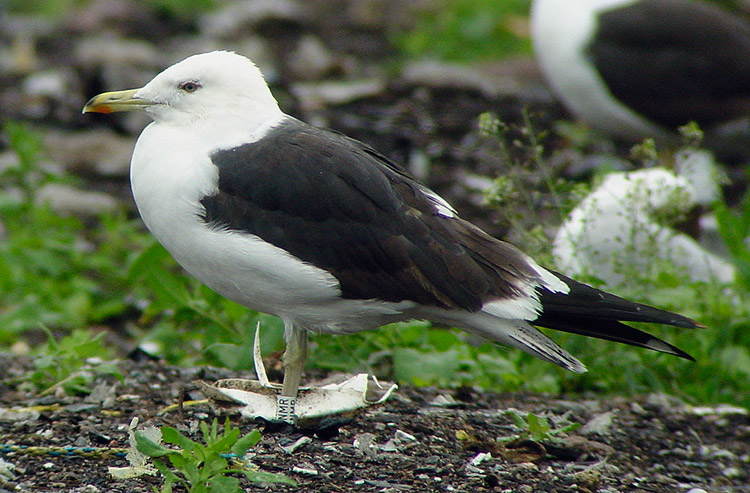
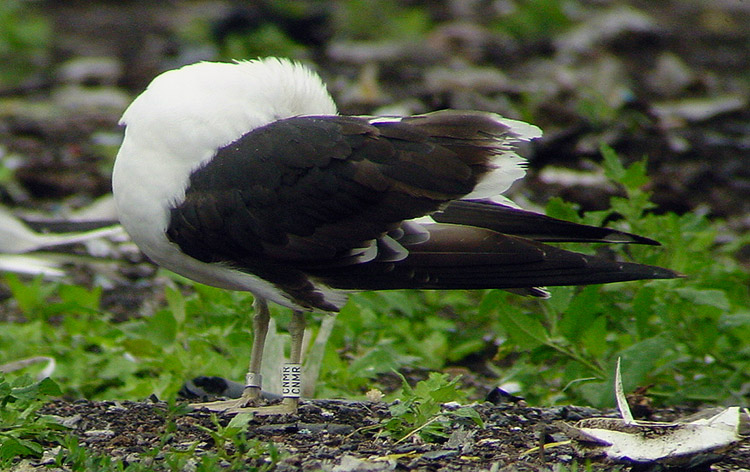
photo below: 3cy LBBG graellsii / intermedius, October 14 2001 Westkapelle, the Netherlands.
Images added to compare inner primaries. This image shows a 3cy LBBG with new 3rd generation inner primaries. Note the obvious black sub-terminal band on P4-P6, especially on P5. P6 is full-grown with a broad black sub-terminal band and clear white tip, P7 is missing. The outer primaries, P8-P10, are old 2nd generation without tips and no mirror on P10.
3cy graellsii / intermedius on average moult P5 by mid-July in their 3rd calendar year. This new 3rd generation P5 has a white tip and a black sub-terminal band, contrary the largely plain brown 2nd generation P5. There is often a white crescent visible between this black sub-terminal band and the central grey inner-web.
3cy fuscus on average moult the primaries half a year earlier, on the wintering grounds. These primaries look more immature, with P5 dark brown, with a paler inner-web and a small white tip.

|
 nominate Lesser Black-backed Gull (L. fuscus)
nominate Lesser Black-backed Gull (L. fuscus)





